News
FEBio 2.0 Released
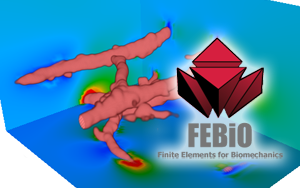 It’s with great pleasure that we announce the release of version 2.0 of FEBio (Finite Elements for Biomechanics). This new version can be downloaded here. FEBio is an open-source finite element package, specifically designed for solving problems in the field of computational biomechanics. This new version includes some major changes and contains a number of new and exciting features. Some of the noteworthy changes and additions are listed below.
It’s with great pleasure that we announce the release of version 2.0 of FEBio (Finite Elements for Biomechanics). This new version can be downloaded here. FEBio is an open-source finite element package, specifically designed for solving problems in the field of computational biomechanics. This new version includes some major changes and contains a number of new and exciting features. Some of the noteworthy changes and additions are listed below.
Chris Butson Joins the SCI Institute as an Associate Professor of Bioengineering
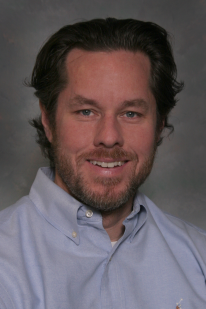 Dr. Butson received a B.S. in Mechanical Engineering from the University of Maryland, M.S. in Electrical Engineering from George Washington University and Ph.D. in Biomedical Engineering from the University of Utah. He completed post- doctoral training at the Cleveland Clinic and for the last six years has been a member of the Biotechnology & Bioengineering Center at the Medical College of Wisconsin (MCW) where he was an Associate Professor in the Departments of Neurology, Neurosurgery, Psychiatry & Behavioral Health at MCW, and an Adjunct Professor in the Department of Biomedical Engineering at Marquette University. He is an active member of the Society for Neuroscience (SFN), the Institute of Electrical & Electronics Engineers (IEEE) and the Engineering in Medicine & Biology Society (EMBS).
Dr. Butson received a B.S. in Mechanical Engineering from the University of Maryland, M.S. in Electrical Engineering from George Washington University and Ph.D. in Biomedical Engineering from the University of Utah. He completed post- doctoral training at the Cleveland Clinic and for the last six years has been a member of the Biotechnology & Bioengineering Center at the Medical College of Wisconsin (MCW) where he was an Associate Professor in the Departments of Neurology, Neurosurgery, Psychiatry & Behavioral Health at MCW, and an Adjunct Professor in the Department of Biomedical Engineering at Marquette University. He is an active member of the Society for Neuroscience (SFN), the Institute of Electrical & Electronics Engineers (IEEE) and the Engineering in Medicine & Biology Society (EMBS). Topological Methods in Data Analysis and Visualization III
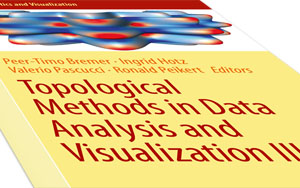 Congratulations to Valerio Pascucci and Peer-Timo Bremer whose co-edited book "Topological Methods in Data Analysis and Visualization III" has just been published.
Congratulations to Valerio Pascucci and Peer-Timo Bremer whose co-edited book "Topological Methods in Data Analysis and Visualization III" has just been published.
Kedar Aras Wins Young Investigator Competition
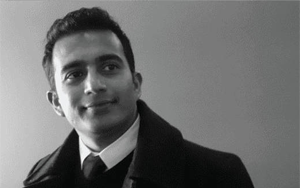 Congratulations to Kedar Aras who won the Young Investigator prize at the 39th Annual International Society for Computerized Electrocardiology (ISCE) conference on April 29th. Judges evaluated finalist presentations based on the originality of the science, quality of the study, and the clarity of the presentation and Q&A. Each speaker was given 15 minutes for their presentation followed by a 15 minute Q&A session.
Congratulations to Kedar Aras who won the Young Investigator prize at the 39th Annual International Society for Computerized Electrocardiology (ISCE) conference on April 29th. Judges evaluated finalist presentations based on the originality of the science, quality of the study, and the clarity of the presentation and Q&A. Each speaker was given 15 minutes for their presentation followed by a 15 minute Q&A session.
2010 Rosenblatt Prize Awarded to Computer Scientist and Director of SCI Institute
 May 7, 2010 -- Christopher R. Johnson, distinguished professor of computer science and director of the Scientific Computing and Imaging (SCI) Institute at the University of Utah, was honored at today's university commencement ceremonies with the Rosenblatt Prize for Excellence, the U's most prestigious award. The $40,000 gift is presented annually to a faculty member who displays excellence in teaching, research and administrative efforts. The Rosenblatt Prize Committee, a group of distinguished faculty members, recommends selected candidates for the award and the university president makes the final selection. U President Michael K. Young presented the award to Johnson, stating, "There is no one who typifies the overall spirit and respected reputation of the Rosenblatt Prize for Excellence more than Chris Johnson. His contributions to the U as a gifted teacher, administrator and world-renowned researcher are invaluable and his work in extending the power and science of computing has quite simply transformed the way we live."
May 7, 2010 -- Christopher R. Johnson, distinguished professor of computer science and director of the Scientific Computing and Imaging (SCI) Institute at the University of Utah, was honored at today's university commencement ceremonies with the Rosenblatt Prize for Excellence, the U's most prestigious award. The $40,000 gift is presented annually to a faculty member who displays excellence in teaching, research and administrative efforts. The Rosenblatt Prize Committee, a group of distinguished faculty members, recommends selected candidates for the award and the university president makes the final selection. U President Michael K. Young presented the award to Johnson, stating, "There is no one who typifies the overall spirit and respected reputation of the Rosenblatt Prize for Excellence more than Chris Johnson. His contributions to the U as a gifted teacher, administrator and world-renowned researcher are invaluable and his work in extending the power and science of computing has quite simply transformed the way we live."
Chris Johnson Honored with 2010 Visualization Career Award
 CHRIS JOHNSON, director of the University of Utah’s Scientific Computing and Imaging Institute, has been honored with the 2010 Visualization Career Award. The award was made in Salt Lake City on Oct. 27, 2010 during VisWeek2010, the premier forum for computer visualization researchers. It is sponsored by IEEE, the Institute of Electrical and Electronics Engineers. Johnson’s award was bestowed by the IEEE’s Visualization and Graphics Technical Committee, which honored him for “sustained technical contributions in scientific visualization, especially in the areas of biomedical and computational field visualization. His research in scientific visualization and scientific computing is important not only because it is innovative, but also because it has important real-world applications in a number of areas.” It is the latest in a string of honors for Johnson, a distinguished professor of computer science and 2010 winner of the University of Utah’s highest honor, the Rosenblatt Prize for Excellence.
CHRIS JOHNSON, director of the University of Utah’s Scientific Computing and Imaging Institute, has been honored with the 2010 Visualization Career Award. The award was made in Salt Lake City on Oct. 27, 2010 during VisWeek2010, the premier forum for computer visualization researchers. It is sponsored by IEEE, the Institute of Electrical and Electronics Engineers. Johnson’s award was bestowed by the IEEE’s Visualization and Graphics Technical Committee, which honored him for “sustained technical contributions in scientific visualization, especially in the areas of biomedical and computational field visualization. His research in scientific visualization and scientific computing is important not only because it is innovative, but also because it has important real-world applications in a number of areas.” It is the latest in a string of honors for Johnson, a distinguished professor of computer science and 2010 winner of the University of Utah’s highest honor, the Rosenblatt Prize for Excellence.
Best Paper Awarded at PacificVis 2014
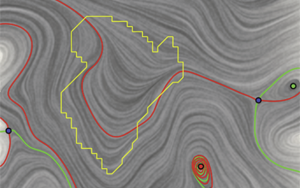 Congratulations to Bei Wang, Paul Rosen, Guoning Chen and their collaborator from Slovenia, Primoz Skraba whose paper:
Congratulations to Bei Wang, Paul Rosen, Guoning Chen and their collaborator from Slovenia, Primoz Skraba whose paper:P. Skraba, Bei Wang, G. Chen, P. Rosen. “2D Vector Field Simplification Based on Robustness,” In Proceedings of the 2014 IEEE Pacific Visualization Symposium, PacificVis, Note: Awarded Best Paper!, 2014.
won "Best Paper" at PacificVis 2014. Their paper presents a new approach to simplification of vector flow fields necessary to reveal essential features within a vector flow field. Traditional methods based on the topological skeleton successively remove pairs of critical points connected by separatrices, using distance or area-based relevance measures. These geometric metrics do not consider the flow magnitude, an important physical property of the flow. The new simplification scheme proposed is based on the recently introduced notion of topological robustness. Robustness enables the pruning of sets of critical points according to a quantitative measure of their stability, that is, the minimum amount of vector field perturbation required to remove them. This leads to a hierarchical simplification scheme that encodes flow magnitude in its perturbation metric.
Big Data, Big Business
 From the University of Utah: Feb. 7, 2014 – The University of Utah's College of Engineering received approval this week for its new graduate certificate program in big data.
From the University of Utah: Feb. 7, 2014 – The University of Utah's College of Engineering received approval this week for its new graduate certificate program in big data.This emerging field – which addresses large sets of data too complex, diverse or rapidly changing for one computer to handle – affects everything from studying traffic patterns to managing sensitive information online. Big data is also big business – for example, using big data to improve efficiency and quality in the health care sector is estimated to be worth more than $300 billion each year.
"We're seeing a revolution in the availability of data. It's easy to collect information, but processing and analyzing large stores of data is becoming increasingly difficult. We are at the point where the traditional analytical tools for attacking this problem are breaking down," says Jeff Phillips, assistant professor of computer science and coordinator of the new program.
SCI's Michael Liu on Winning Team at Hackdance
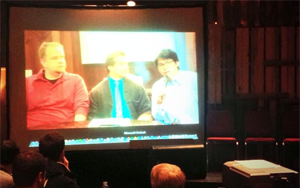 SCI Graduate student Michael Liu was a key member on the team that took the Social Impact award at "Hackdance", the first ever celebrity-driven hackathon at the Sundance Film Festival. The team, working with celebrity member Sarah Austin (StartUps: Silicon Valley on Bravo), developed a prototype browser extension that monitors cyber bullying. Once installed, the extension uses a parts of speech tagger to look for harrassing comments and sentences in any conversations or content. If language is detected in their child's feed that is related to cyberbulling they are sent an alert message via email immediately. The team, which included fellow members Faris Chebib, Joe Reis, Sam Hart and Eric Smith, was awarded a $5,000 investment from the University of Utah’s Sorensen Global Impact Investment Center plus $10,000 worth of business incubation and a trip to meet Jim Sorensen. Congratulations Michael!
SCI Graduate student Michael Liu was a key member on the team that took the Social Impact award at "Hackdance", the first ever celebrity-driven hackathon at the Sundance Film Festival. The team, working with celebrity member Sarah Austin (StartUps: Silicon Valley on Bravo), developed a prototype browser extension that monitors cyber bullying. Once installed, the extension uses a parts of speech tagger to look for harrassing comments and sentences in any conversations or content. If language is detected in their child's feed that is related to cyberbulling they are sent an alert message via email immediately. The team, which included fellow members Faris Chebib, Joe Reis, Sam Hart and Eric Smith, was awarded a $5,000 investment from the University of Utah’s Sorensen Global Impact Investment Center plus $10,000 worth of business incubation and a trip to meet Jim Sorensen. Congratulations Michael!For more information see: Silicon Bayou News: First Celebrity-Driven, Social Impact Hackathon Makes Splash at Sundance
Computer Simulation of Blood Vessel Growth: Early Step toward Treatment for Diseases that Affect Blood Flow
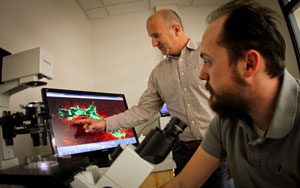 Jan. 22, 2014 – University of Utah bioengineers showed that tiny blood vessels grow better in the laboratory if the tissue surrounding them is less dense. Then the researchers created a computer simulation to predict such growth accurately – an early step toward treatments to provide blood supply to tissues damaged by diabetes and heart attacks and to skin grafts and implanted ligaments and tendons.
Jan. 22, 2014 – University of Utah bioengineers showed that tiny blood vessels grow better in the laboratory if the tissue surrounding them is less dense. Then the researchers created a computer simulation to predict such growth accurately – an early step toward treatments to provide blood supply to tissues damaged by diabetes and heart attacks and to skin grafts and implanted ligaments and tendons.
Chris Johnson and Ross Whitaker Elected IEEE Fellows
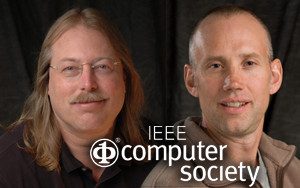 Congratulations to Professors Chris Johnson and Ross Whitaker who have been elected IEEE Fellows for the class of 2014. Dr. Johnson was elected in recognition of his leadership in scientific computing and scientific visualization. Dr. Whitaker is recognized for contributions to image and geometry processing, visualization, and medical image analysis. This honorary designation is limited to no more than one-tenth of one percent of the total voting IEEE Institute membership each year.
Congratulations to Professors Chris Johnson and Ross Whitaker who have been elected IEEE Fellows for the class of 2014. Dr. Johnson was elected in recognition of his leadership in scientific computing and scientific visualization. Dr. Whitaker is recognized for contributions to image and geometry processing, visualization, and medical image analysis. This honorary designation is limited to no more than one-tenth of one percent of the total voting IEEE Institute membership each year.




